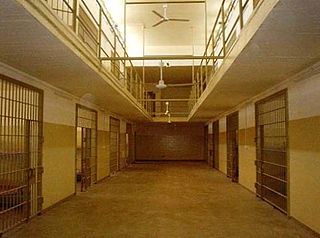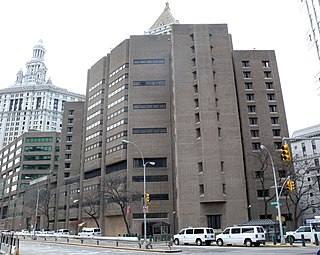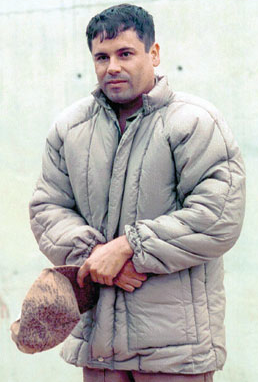
Abu Ghraib prison was a prison complex in Abu Ghraib, Iraq, located 32 kilometers (20 mi) west of Baghdad. Abu Ghraib prison was opened in the 1950s and served as a maximum-security prison. From the 1970s, the prison was used by Saddam Hussein to hold political prisoners and later the United States to hold Iraqi prisoners. It developed a reputation for torture and extrajudicial killing, and was closed in 2014.

Camp Bucca was a forward operating base that housed a theater internment facility maintained by the United States military in the vicinity of Umm Qasr, Iraq. After being taken over by the U.S. military in April 2003, it was renamed after Ronald Bucca, a New York City fire marshal who died in the 11 September 2001 attacks. The site where Camp Bucca was built had earlier housed the tallest structure in Iraq, a 492-meter-high TV mast.

During the early stages of the Iraq War, members of the United States Army and the Central Intelligence Agency committed a series of human rights violations and war crimes against detainees in the Abu Ghraib prison in Iraq, including physical abuse, sexual humiliation, both physical and psychological torture, rape, as well the killing of Manadel al-Jamadi and the desecration of his body. The abuses came to public attention with the publication of photographs of the abuse by CBS News in April 2004. The incidents caused shock and outrage, receiving widespread condemnation within the United States and internationally.

Secret passages, also commonly referred to as hidden passages or secret tunnels, are hidden routes used for stealthy travel, escape, or movement of people and goods. They are sometimes inside buildings leading to secret rooms.

Joaquín Archivaldo Guzmán Loera, commonly known as "El Chapo" and "JGL", is a Mexican former drug lord and a former leader within the Sinaloa Cartel, an international crime syndicate. He is considered to have been one of the most powerful drug traffickers in the world.

The Metropolitan Correctional Center, New York is a temporarily closed United States federal administrative detention facility in the Civic Center of Lower Manhattan, New York City, located on Park Row behind the Thurgood Marshall United States Courthouse at Foley Square. It is operated by the Federal Bureau of Prisons, a division of the United States Department of Justice.
Revolutionary Struggle is a Greek anarchist, anti-imperialist, urban guerrilla group known for its attacks on Greek government buildings and the American embassy in Athens. It is designated as a terrorist group by the Greek government, the European Union (EU), and the United States.
During the Iraq War, many insurgents, al-Qaeda and militant fighters were captured and held at military bases in the region. On several occasions, there were instances of prisoner escapes.

The Sinaloa Cartel, also known as the Guzmán-Zambada Organization, the Federation, the Blood Alliance, or the Pacific Cartel, is a large, international organized crime syndicate that specializes in illegal drug trafficking and money laundering. It was established in Mexico during the late 1980s as one of a various number of subordinate "plazas" operating under a predecessor organization known as the Guadalajara Cartel. It is currently headed by Ismael Zambada García and is based in the city of Culiacán, Sinaloa, with operations in many world regions but primarily in the Mexican states of Sinaloa, Baja California, Durango, Sonora, and Chihuahua. and presence in a number of other regions in Latin America as well as in cities across the U.S. The United States Intelligence Community generally considers the Sinaloa Cartel to be the largest and most powerful drug trafficking organization in the world, making it perhaps even more influential and capable than Pablo Escobar's infamous Medellín Cartel of Colombia was during its prime. According to the National Drug Intelligence Center and other sources within the U.S. the Sinaloa Cartel is primarily involved in the distribution of cocaine, heroin, methamphetamine, fentanyl, cannabis and MDMA.
The Sarposa Prison attack was a raid on the Sarposa Prison in Kandahar, Afghanistan by Taliban insurgents on June 13, 2008. One of the largest attacks by Afghan insurgents, the raid freed 400-1000 prisoners. As of 2008, prison administration was overseen by Abdul Qabir.
Kandahar Central Jail, also known as Sarpuza Prison or Sarposa Prison, is a minimum security prison in Kandahar, Afghanistan. It has been historically used for the incarceration of common criminals of Kandahar Province. In the last two decades, the facility has also been used to hold up Taliban and other insurgents. The name "Sarpuza" is a historical neighborhood in the city of Kandahar. As of 2017, the prison has approximately 1,900 inmates, and its warden is Col. Abdul Wali Hesarak.

The 2006 Gaza cross-border raid was an armed incursion carried out by seven or eight Gazan Palestinian militants on 25 June 2006 who attacked Israel Defense Forces (IDF) positions near the Kerem Shalom Crossing through an attack tunnel. In the attack, two IDF soldiers and two Palestinian militants were killed, four IDF soldiers were wounded, one of whom was Gilad Shalit, who was captured and taken to the Gaza Strip.

Joaquín "El Chapo" Guzmán, the former leader of the Sinaloa Cartel, dodged international manhunt for more than a decade after escaping from a maximum-security prison in the Mexican state of Jalisco in 2001. Throughout his criminal career following his escape, Guzmán was pursued all across Mexico and abroad, and went from being an average-level drug lord to arguably the world's most-wanted man. Mexico offered MXN$30 million for his capture, while the United States offered up to US$5 million for information leading to his arrest and conviction. In 1993, he was arrested and imprisoned for murder and drug trafficking, facing a 20-year sentence. Fearing his extradition to the U.S., Guzmán fled from prison by reportedly hiding in a laundry cart in 2001. He quickly reincorporated back in the Sinaloa Cartel while authorities continued their manhunt to re-arrest him.

Operation Black Swan was a joint U.S. and Mexican-led military operation that resulted in the recapture of the Sinaloa Cartel leader, Joaquín "El Chapo" Guzmán, following a deadly firefight in the city of Los Mochis, Sinaloa, on 8 January 2016. Officials in the Mexican government announced that the operation was planned and executed by the Mexican Navy Special Forces, and that they had originally targeted an important Sinaloa Cartel assassin at a home in Los Mochis, and happened to find Guzmán as well. U.S. government officials announced that members of the United States Army's Delta Force and the U.S. Marshals assisted the Mexican Marines in the 8 January mission, and will pursue the extradition of Guzmán to the United States.

United States of America v. Joaquín Guzmán Loera was a federal criminal court case against Joaquín "El Chapo" Guzmán, a Mexican drug lord and former leader of the Sinaloa Cartel. Guzmán was extradited from Mexico to the United States in January 2017, where he pleaded not guilty to all counts against him in Brooklyn, New York. His charges included drug trafficking, money laundering, and murder. His defense asserted that he was not the organized crime leader that the prosecution claimed. The trial, often characterized as a trial of the century, began on November 5, 2018, and lasted until February 12, 2019, when the jury returned a verdict of guilty on all counts. He was sentenced on July 17, 2019 to a prison term of life.
The Dêrik prison escape attempt was an organized revolt at the detention center in al-Malikiyah (Dêrik), Syria on 5 April 2019, attempted by prisoners belonging to the Islamic State of Iraq and the Levant. The detainees launched a coordinated uprising to facilitate a breakout, but were foiled by the quick intervention of local security forces and the United States Air Force.

The 2022 Battle of al-Hasakah was a large-scale Islamic State attack and prison riot aimed at freeing arrested fighters of the Islamic State from al-Sina'a prison in the Ghuwayran (Geweran) area of Al-Hasakah, Syria, which resulted in a partial strategic victory and major propaganda victory for the Islamic State, with hundreds of prisoners, including important Emirs, being freed from captivity. The attack was the largest attack committed by the Islamic State since it lost its last key Syrian territory in 2019.













